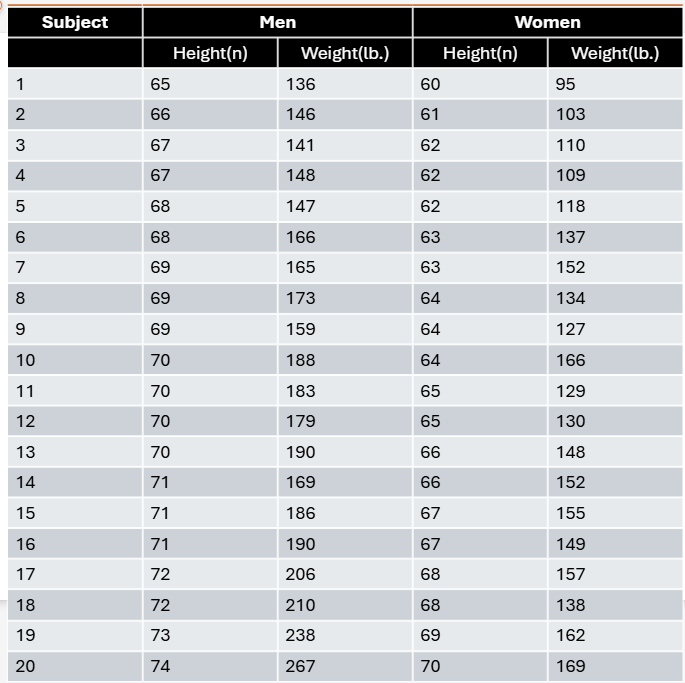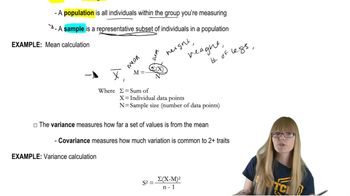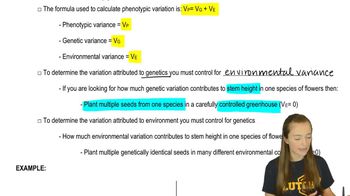Table of contents
- 1. Introduction to Genetics51m
- 2. Mendel's Laws of Inheritance3h 37m
- 3. Extensions to Mendelian Inheritance2h 41m
- 4. Genetic Mapping and Linkage2h 28m
- 5. Genetics of Bacteria and Viruses1h 21m
- 6. Chromosomal Variation1h 48m
- 7. DNA and Chromosome Structure56m
- 8. DNA Replication1h 10m
- 9. Mitosis and Meiosis1h 34m
- 10. Transcription1h 0m
- 11. Translation58m
- 12. Gene Regulation in Prokaryotes1h 19m
- 13. Gene Regulation in Eukaryotes44m
- 14. Genetic Control of Development44m
- 15. Genomes and Genomics1h 50m
- 16. Transposable Elements47m
- 17. Mutation, Repair, and Recombination1h 6m
- 18. Molecular Genetic Tools19m
- 19. Cancer Genetics29m
- 20. Quantitative Genetics1h 26m
- 21. Population Genetics50m
- 22. Evolutionary Genetics29m
20. Quantitative Genetics
Analyzing Trait Variance
Problem 31b
Textbook Question
A total of 20 men and 20 women volunteer to participate in a statistics project. The height and weight of each subject are given in the table. Calculate the mean, variance, and standard deviation for height and weight in men and women.

 Verified step by step guidance
Verified step by step guidance1
Organize the data by separating the height and weight values for men and women into four distinct groups: men's heights, men's weights, women's heights, and women's weights.
Calculate the mean (average) for each group using the formula: , where represents each individual measurement and is the number of individuals (20 in this case).
Compute the variance for each group by first finding the squared difference between each measurement and the mean, then averaging these squared differences using the formula: .
Determine the standard deviation for each group by taking the square root of the variance, expressed as: .
Summarize the results by listing the mean, variance, and standard deviation for height and weight separately for men and women, ensuring clarity in the presentation of each statistical measure.
 Verified video answer for a similar problem:
Verified video answer for a similar problem:This video solution was recommended by our tutors as helpful for the problem above
Video duration:
1mPlay a video:
Was this helpful?
Key Concepts
Here are the essential concepts you must grasp in order to answer the question correctly.
Mean
The mean is the average value of a data set, calculated by summing all observations and dividing by the number of observations. It provides a measure of central tendency, representing the typical value in the data, such as average height or weight.
Recommended video:
Guided course

Mathematical Measurements
Variance
Variance measures the spread or dispersion of data points around the mean. It is calculated as the average of the squared differences between each data point and the mean, indicating how much the values vary within the group.
Recommended video:
Guided course

Analyzing Trait Variance
Standard Deviation
Standard deviation is the square root of the variance and expresses data variability in the same units as the original measurements. It quantifies the typical distance of data points from the mean, helping to understand the consistency of height or weight within men or women.
Recommended video:
Guided course

Mathematical Measurements

 8:34m
8:34mWatch next
Master Analyzing Trait Variance with a bite sized video explanation from Kylia
Start learningRelated Videos
Related Practice
Textbook Question
Suppose the mature height of a plant is a multifactorial trait under the control of five independently assorting genes, designated A, B, C, D, and E, and five environmental factors. There are two alleles of each gene (A₁, A₂, etc.). Each allele with a subscript 1 (i.e., A₁) contributes 5 cm to potential plant height, and each allele with a 2 subscript (i.e., A₂, etc.) contributes 10 cm to potential plant height. In other words, a genotype containing only 1 alleles (A₁A₁B₁B₁C₁C₁D₁D₁E₁E₁) would have a potential height of [(10)(5)]=50cm, and a genotype with only 2 alleles (A₂A₂B₂B₂C₂C₂D₂D₂E₂E₂) would have a potential height of [(10)(10)]=100cm.The five environmental factors are (1) amount of water, (2) amount of sunlight, (3) soil drainage, (4) nutrient content of soil, and (5) temperature. Each environmental factor can vary from optimal to poor. If all factors are optimal, assume that full potential height is attained. However, if one or more of the environmental factors is less than optimal, then height is reduced. The state of each environmental factor has an effect on growth. In this exercise, we'll assume that the growth is affected according to the following scale:Environmental Factor State Height LostOptimal (O) 0 cmGood (G) 4 cmFair (F) 8 cmMarginal (M) 12 cmPoor (P) 16 cmThus, for example, if one environmental factor is optimal, two are good, one is fair, and one is marginal, the loss of potential height is . If the loss of height potential is greater than the height potential of the plant, the plant does not survive.How many 1 and 2 alleles must be present to give a height potential of 80 cm?
395
views
